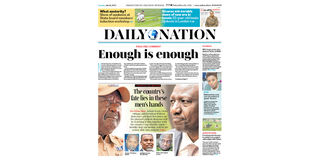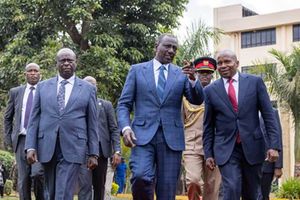Enough is enough: When media decide to bring out the big guns

It is a tradition in Kenya for the media to come out with one voice when the country is teetering on the brink of chaos or is faced with a calamity.
This happened, for example, when the country descended into near-civil war during the post-election violence in December of 2007 that spilt into the following year. All the country’s major newspapers came out on January 3, 2008 with a joint front-page editorial with the same headline: “Save Our Beloved Country.”
The common editorial said our beloved country was a burnt-out smouldering ruin. “The economy is at a virtual standstill and the armies of destruction are on the march in the Rift Valley and other places,” the editorial said. “Let those with armies call them back, let those fanning the fires stamp them out so that an environment is created for constructive dialogue.”
On Tuesday, Nation Media Group (NMG) was the only media house that came out with a front-page editorial ahead of the opposition-led demonstrations, more commonly known as “maandamano”, on Wednesday, urging President William Ruto and former Prime Minister Raila Odinga to do the right thing and save this country from chaos.
The page one comment, titled “Enough is enough”, said the nation is bigger than Dr Ruto and Mr Odinga and they must climb down from their high horses and restore peace and harmony in the country.
“President Ruto and Mr Odinga must unite the country and desist from beating the war drums and pushing us into a crisis,” the editorial concluded.
Three-day demonstrations
Dr Ruto and Mr Odinga did not get off their high horses and maandamano took place as scheduled, setting off the planned three-day demonstrations spearheaded by the Odinga-led Azimio la Umoja One Kenya Coalition Party, the country’s main political opposition.
Many readers welcomed the Nation page-one comment. Githaiga Kairu, a keen and critical reader of the Nation, typically said the editorial was spot on. “[The editorial] called a spade a spade and did a proper dressing-down of the combatants,” he said.
Following the breakout of chaos on Wednesday and the prospect of continued demonstrations, chaos, destruction and loss of life, yesterday, the Nation published a second front-page editorial. And, this time, it was joined by all the other major media houses. The united plea was: “Let’s save our country.”
“This nation stands on the precipice,” the joint editorial said. “Unless reason prevails, we could all very well tumble down into a dark and dangerous abyss from which it could be almost impossible to extricate ourselves.” It concluded: “At the end of the day, we all live in one nation, sailing on the same boat. If it sinks, we will all go down with it. Nobody will be spared.”
The value of a front-page editorial lies in its unusualness and the fact that it is read by large numbers of people who would not normally read an editorial. Normally, editorials are published in the inside pages and rarely on the front page, which is reserved for the most important or interesting news of the day.
Editors publish editorials on the front page when they think the message is of such tremendous importance to readers and the community that it needs to be treated like headline news. By placing the editorial on the front page, a newspaper is literally bringing out its big guns.
When the Nation went solo with its Tuesday front-page editorial, the same editorial was also broadcast as “The Memo’” in NTV Tonight news programme and reproduced on the front pages of its sister publications, Taifa Leo and Business Daily. The same treatment was accorded the second front-page editorial that was published yesterday.
When editorials are published on the front page, they become powerful messages that shape the conversations for the day. But for that to happen, they, however, need to be of broad interest, hard-hitting and well-crafted, and they should be very rare.
On the whole, the Nation front-page editorials met those standards and that is why they have remained significant. With the help of librarian Anniel Njoka, I could only find 11 Nation front-page editorials in the past 17 years—apart from the ones published on Tuesday and yesterday. That shows the Nation rarely calls out its big guns. And that is the way it should be.
If front-page editorials were used too often, they would lose their impact. People pay attention to them because they are unusual.
- The Public Editor is an independent news ombudsman who handles readers’ complaints on editorial matters including accuracy and journalistic standards. Email: [email protected]. Call or text 0721989264.





